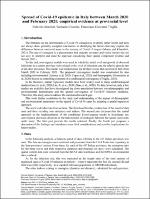Chapter Spread of Covid-19 epidemic in Italy between March 2020 and February 2021: empirical evidence at provincial level
| dc.contributor.author | Truglia, Francesco Giovanni | |
| dc.contributor.author | Antolini, Fabrizio | |
| dc.contributor.author | Cesarini, Samuele | |
| dc.date.accessioned | 2023-08-03T15:05:49Z | |
| dc.date.available | 2023-08-03T15:05:49Z | |
| dc.date.issued | 2023 | |
| dc.identifier | ONIX_20230803_9791221501063_87 | |
| dc.identifier.issn | 2704-5846 | |
| dc.identifier.uri | https://library.oapen.org/handle/20.500.12657/74891 | |
| dc.description.abstract | Italy was one of the countries severely affected by the Covid-19 pandemic. An analysis of the factors that played a role in the spread of this epidemic is necessary. However, the assessment of which factors may be specific, and which may contribute the most is complex and involves a high degree of uncertainty. The main objective of this study is to evaluate and analyse the statistical associations of the spread of Covid-19 infection with identified spatial context variables (density, old-age index, average temperature, and pollution). For this purpose, the developments from the spatial convergence theory were considered, as well as data from the Italian provinces from March 2020 to February 2021, referring to the first, second and third wave. The hypothesis tested in this study is to investigate the contribution of environmental and demographic factors to the convergence of observed infection rates. Based on panel data of 107 Italian provinces from the first to the third wave, this article uses a spatial autoregressive model (SAR) to analyse the conditional β-convergence of Covid-19 infection rates. The empirical results of this paper show that there is spatial conditional β-convergence in the intensity of infection rates. This means that the contagion in neighbouring areas will affect the contagion in the local area. The age structure and population density of the provinces had a certain promoting effect on the transmission of the infection, depending on the wave analysed. Regarding the observed average temperature, the effects are not very significant and inconsistent. For the first and last wave, the level of pollution is significant in explaining the convergence processes of the infection. We demonstrate that accounting for spatial factors is essential to capture key features of the spread of Covid-19 infection. | |
| dc.language | English | |
| dc.relation.ispartofseries | Proceedings e report | |
| dc.subject.classification | thema EDItEUR::J Society and Social Sciences | en_US |
| dc.subject.other | Covid-19 | |
| dc.subject.other | Italian provinces | |
| dc.subject.other | Conditional β-convergence | |
| dc.subject.other | SAR model | |
| dc.title | Chapter Spread of Covid-19 epidemic in Italy between March 2020 and February 2021: empirical evidence at provincial level | |
| dc.type | chapter | |
| oapen.identifier.doi | 10.36253/979-12-215-0106-3.19 | |
| oapen.relation.isPublishedBy | 9223d3ac-6fd2-44c9-bb99-5b98ca9d2fad | |
| oapen.relation.isPartOfBook | 863aa499-dbee-4191-9a14-3b5d5ef9e635 | |
| oapen.relation.isbn | 9791221501063 | |
| oapen.series.number | 134 | |
| oapen.pages | 6 | |
| oapen.place.publication | Florence |

